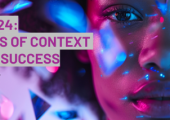Who’s Killing Creativity Now?
Market research has long been accused of killing creativity. Many in the creative world now look back with nostalgia to the days when market research was the point of contention. With so much more data available now and so many exciting applications for it, data and creative are at loggerheads.
Perhaps it goes without saying that times have changed in the media, brand and communications landscape. Yet there is a debate raging. We are witness to an increasingly uncomfortable tension between creativity and data (especially data science).
Creativity comes in the guise of campaigns and content across multiple media that often target a wider audience; data comes in the guise of targeted and often personalised campaigns, frequently but not exclusively digital. While each may accept that the other has a place in the world, each also highlights the weaknesses of the other.
Data doesn’t kill creativity; people kill creativity. Likewise, just because creativity can be more difficult to measure, it doesn’t mean it is not working.
So what do data-driven content and communications bring? They are pushing the industry in new directions, where people already are. Our Tech Tracker shows that nine in ten British adults are accessing the Internet and over three quarters of these users are accessing on mobile1. Seven in ten own a smartphone. Figures are even higher among young people. The world has changed and will continue to do so. There are undoubtedly some great examples of using data to grow.
What of creativity? Creativity is important to brand success. According to an IPA review of the Gunn report and the IPA databank, creatively awarded campaigns generate eleven times more share growth per ten points of Excess Share of Voice Likewise, Les Binet and Peter Field have shown in their review of the IPA databank that Fame campaigns – campaigns that create salience – outperform brand impact on all key metrics, including sales, market share, price sensitivity, loyalty, penetration, and profit4. And the Ipsos database shows that 75% of an ad’s ability to leave brand-linked memories is due to creative. This helps explain what Binet and Field have demonstrated: that long-term effects are not just an accumulation of short-term effects and that long-term brand-building is critical to long-term profitability.
In truth, both wider-reach creative, and more targeted, data-driven comms and content have a role to play for any brand. Fame is still important and creativity (and emotion) critical in driving success.
The challenge is this: the ‘data’ side can be better understood by the boardroom. Highly targeted data-driven comms and content are fast, with easy measures and promises of minimal wastage. What CFO or CEO wouldn’t want that? It can be much harder for long-term brand building – which is more often driven by creatively expressed ideas and values – to get a look-in.
Not everything that is necessary to build brands is easily measured, and not everything that is easily measured is necessary to build brands. The consumer, the audience, the people are an essential part of brand success. Without thought and context behind it, data is just numbers.
Like all of the best tensions, the data vs. creativity tension can resolve into a sparky relationship. The question should not be either / or but how they can both work together to build an individual brand. The truth is that a wide array of tools will be needed. We help many clients to find ways to make these work together and also to anchor long-term brand building in measures that the boardroom can understand.
Insight, properly used, can act as a rudder to steer the brand. This goes beyond the technology measured in ‘data’: insight is needed to bring those people to the heart of building brands. Brands must be present, remembered and relevant in the moments that matter. There are many ways that insight can and should help, whether in creative or data-driven campaigns or some combination thereof.
At Ipsos, we believe that there will never be one single number to tell you the right answer but rather that art must meet science to create something relevant, distinctive and memorable. We work closely with our clients to ensure that research unites data and creativity. By measuring at the point of people receiving the communications not the point of transmission, we can understand the true impact and help creativity to have a stronger voice in the boardroom.

